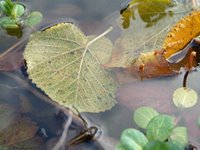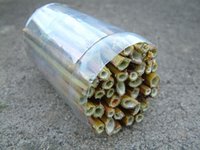The urban potential of wildlife gardening
It has been estimated that 23% of the area of urban
| For more wildlife gardening advice, ebooks, information, projects and jokes please visit: www.thewildlifegarden.co.uk |
Wildlife gardening - timely advice throughout the year, projects etc. Information on wild flowers, birds, butterflies, bumblebees, mason bees, ladybirds, lacewings, frogs, etc. If it's to do with garden wildlife, you will find it here!
It has been estimated that 23% of the area of urban
| For more wildlife gardening advice, ebooks, information, projects and jokes please visit: www.thewildlifegarden.co.uk |
 As with most forms of gardening, wildlife gardening requires us to plan ahead. One task this month that could pay dividends next year is to remove fallen leaves from the pond. As leaves rot they release minerals and nutrients. Next spring you could end up with pea soup if the nutrients encourage an algal bloom.
As with most forms of gardening, wildlife gardening requires us to plan ahead. One task this month that could pay dividends next year is to remove fallen leaves from the pond. As leaves rot they release minerals and nutrients. Next spring you could end up with pea soup if the nutrients encourage an algal bloom. | For more wildlife gardening advice, ebooks, information, projects and jokes please visit: www.thewildlifegarden.co.uk |
 The native 'old man’s beard' or traveller's joy' (Clematis vitalba), as it is variously known, doesn't need pruning to encourage flowers but if it is challenging your patience you can cut it back by two-thirds this month. It is best left bushy, however, as it is a good nesting site for birds.
The native 'old man’s beard' or traveller's joy' (Clematis vitalba), as it is variously known, doesn't need pruning to encourage flowers but if it is challenging your patience you can cut it back by two-thirds this month. It is best left bushy, however, as it is a good nesting site for birds. | For more wildlife gardening advice, ebooks, information, projects and jokes please visit: www.thewildlifegarden.co.uk |
 With the arrival of autumn frosts the borders become littered with dry, brown perennial stems. It can be tempting for the tidy gardener to rush out and cut them down yet there is good reason to leave them. Apart from the fact they often look pretty when frost crystals form on them and glisten in the sun, they are also a winter refuge for hibernating insects. A number of these insects are great natural pest controllers in the summer months, especially aphid-eating ladybirds and lacewings.
With the arrival of autumn frosts the borders become littered with dry, brown perennial stems. It can be tempting for the tidy gardener to rush out and cut them down yet there is good reason to leave them. Apart from the fact they often look pretty when frost crystals form on them and glisten in the sun, they are also a winter refuge for hibernating insects. A number of these insects are great natural pest controllers in the summer months, especially aphid-eating ladybirds and lacewings. | For more wildlife gardening advice, ebooks, information, projects and jokes please visit: www.thewildlifegarden.co.uk |
Please visit my website at www.thewildlifegarden.co.uk for wildlife gardening advice, projects, jokes, etc!